JavaScript is an essential programming language for designing websites. Its multipurpose nature and ubiquitous use have made it an invaluable asset to web developers and popular JavaScript Statistics for organizations that strive to improve their online presence and interaction.
JavaScript’s influence goes beyond web development, being used across diversified industries. The e-commerce sector uses JavaScript to achieve dynamic content, interactive features, and smooth user experiences. In the finance and banking sectors, JavaScript is used for data visualization, interactive dashboards, and secure client-side scripting. JavaScript is equally important in the healthcare and education sectors in providing users wonderful digital environment.
With the development of technology, JavaScript is constantly improving too. Emerging trends like the increase in serverless computing or WebAssembly acceptance are determining the shape of JavaScript programming. Furthermore, the increasing popularity of mobile-first and cross-platform applications dictates the demand for best JavaScript frameworks and tools.
This article will touch on the JavaScript Usage Statistics and factors important to enterprise-level decision-makers like you. Gaining insights from these statistics can help you decide on favorable strategies for web development, employment, and JavaScript tech implementation.
Understanding JavaScript Usage
JavaScript is the foundation of web development that powers over 95% of all sites on the net. Its omnipresent nature is a result of the fact that it allows for the development of dynamic and interactive web content, which brings the user experience to a new level. JavaScript statistics leveraged provide you with invaluable knowledge that you can use to figure out the correct web development strategies and investment plan.
With JavaScript, you can update the page in real-time, use an interactive map, animate graphics, and have smooth scrolling, among other things. It enables the design of adaptable websites for distinct devices, thus increasing usability. Through the knowledge of JavaScript Usage Statistics, you can shape your business roadmap with the customers’ dynamic needs and thus be on the cutting edge of the market.
Moreover, client-side JavaScript execution reduces server load, resulting in quicker processing and better website performance. The extensive and constantly changing community of JS developers involves it to be a flagship for web development. Familiarizing yourself with the newest JavaScript data and trends can help you hire the best and stick to them so that your web development is staffed with the best possible people.
Key JavaScript Statistics
JavaScript Usage and Adoption Trends:
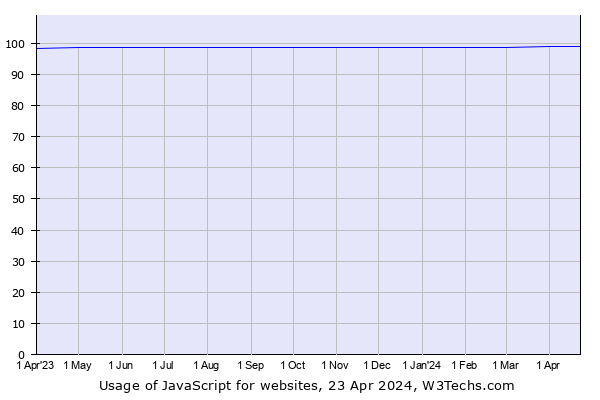
- Global Website Usage: About 98.7% of websites (approx. 49,501,698 websites) apply JavaScript as a client-side programming language, which illustrates the widespread usage of this language on the internet.
- Geographical Distribution: India has 584,129 websites, while the USA has 16,988,910 JavaScript websites.
- Developer Interest: 48% of developers express their wish to study React.js, one of the most common JavaScript frameworks, which shows a tendency for growth and popularization.
- Programming Language Popularity: JavaScript is the most used globally by 63.61% of users while surpassing HTML/CSS and Python.
- Company Adoption: By 2024, the total count of businesses using JavaScript languages globally will be 14,180,365, underscoring the high level of acceptance the language has among businesses across industries.
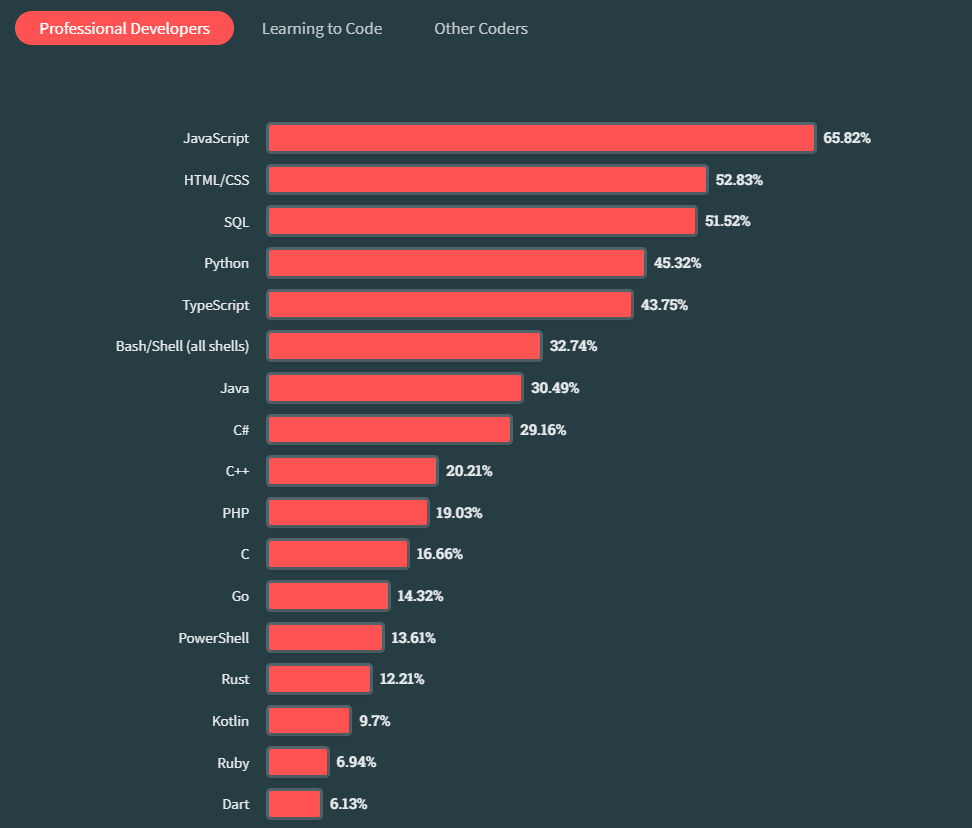
- Developer Preference: Stack Overflow’s Development Survey shows that 65.82% of professional developers use JavaScript more often than every other language.
- Geographical Distribution: As reported by Stack Overflow, the US accounts for the majority share of JavaScript developers (17.5%), and it is followed by Germany (7.6%), France (5.5%), UK (5.2%), and India (4.7%), which conforms to the global distribution of developers.
- Demographic Insights: JavaScript developers generally have an age range between 25 and 34 years old (48%), 93% of whom are males, whereas 68.8% are Whites (German, Irish, English, Italian, Lebanese, and Egyptian). The majority (43.5%) of developers work at firms with more than 100 employees.
- TypeScript Adoption: The State of JS survey reveals that TypeScript has earned a high rank with 28% of developers using it as the main language while JavaScript is used by only 11.1% of them.
- Annual JavaScript Usage Growth: From 2019 to 2022, the global usage of JavaScript has grown by a tremendous 78%.
- JavaScript Dominance in Web Development: Approximately 97.7% of all websites use JavaScript, which stands as the most popular programming language for web development.
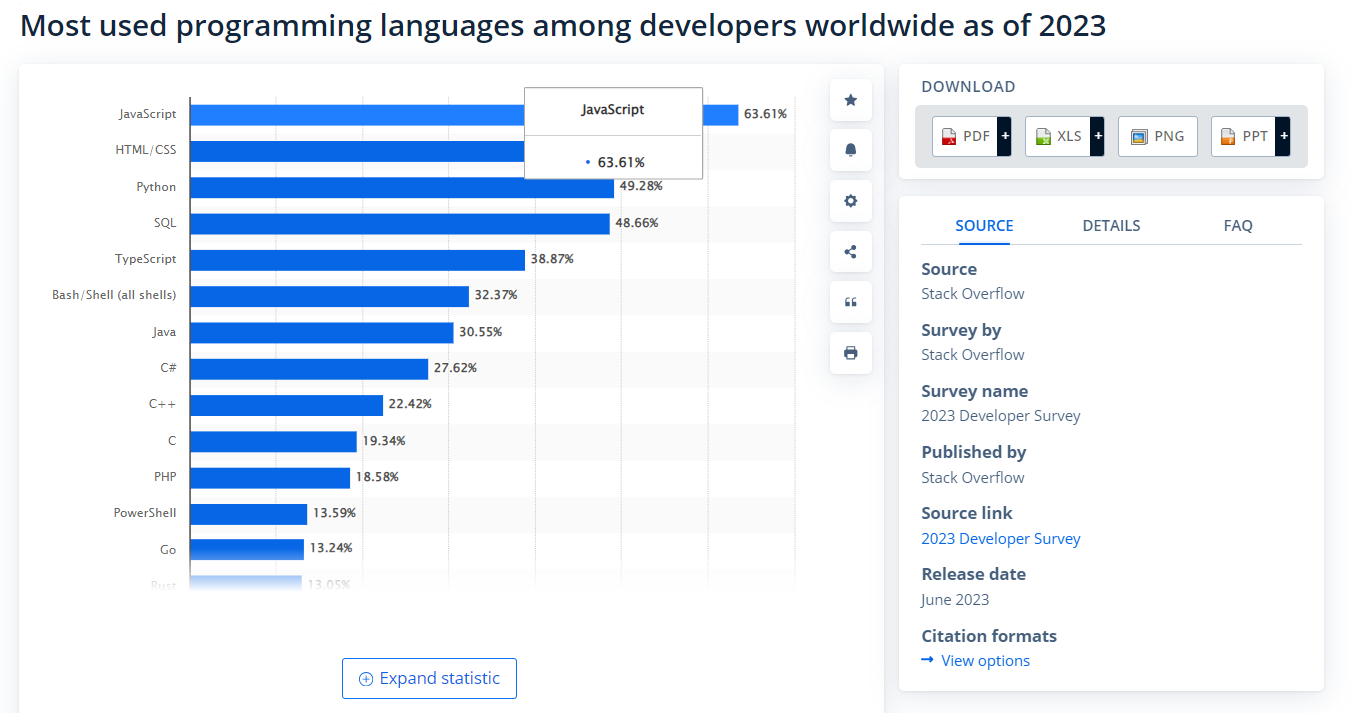
- Global Usage: Statista indicates that 63.61% of the developers globally use JavaScript, which is the most widely used programming language of all, and then HTML/CSS (52.97%) and Python (49.28%).
- JavaScript Job Market Demand: The need for JavaScript coders is predicted to rise by 23% from 2021 to 2031 as per Zippia.
- JavaScript Talent Pool: Javascript maintains its 10-year-old record of being the most popular programming language accounting for 20 million active developers worldwide.
JavaScript’s Versatility and Diverse Applications:
- JavaScript is used within various sectors as web development, mobile app creation, games, and more.
- Server-side JavaScript with Node.js: Node.js, a JavaScript runtime built on Chrome’s V8 JavaScript engine, has become the de facto standard, with 42.73% of developers making it their first choice for server-side development.
- JavaScript libraries have made many difficult coding tasks simple, allowing developers to browse the web using interactive pages.
- Aside from website and mobile app development, JavaScript is used in a broad variety of applications including the provision of Internet of Things (IoT) products, fintech apps, e-commerce websites, and Peer-to-Peer (P2P) services.
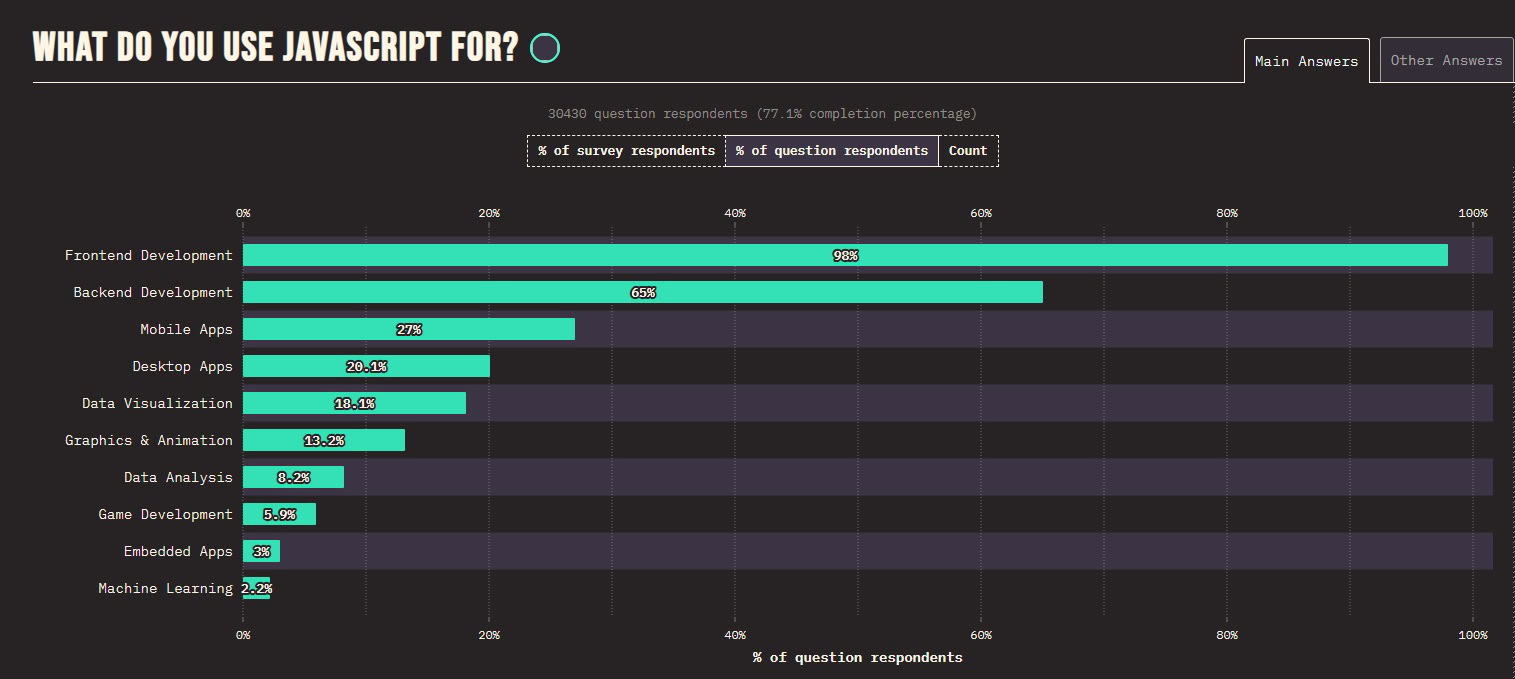
- Professional Usage: 84.7% of JavaScript developers use it professionally, primarily for frontend development (98%), then in the backend (65%), mobile apps (27%), desktop apps (20.1%), and data visualization (18.1%).
- Industry Application: JavaScript is widely accepted in various sectors with 46.6% of developers in the “Programming & Technical” area, 30.3% in “E-commerce & Retail”, and 17.5% in “Finance.”
The Impact of JavaScript on Business Performance:
- The client-side code is executed in JavaScript, thus the server load is reduced along the processing time is made faster.
- It is also possible to optimize sitewide JavaScript to improve performance by using such techniques as minification and caching.
- JavaScript offers companies a broad scope of business advantages. One of the most important things for this level of business is the improvement of efficiency.
- Enhanced User Experience: A JavaScript-powered website allows dynamic delivery of content, which supports better user engagement and satisfaction, resulting in more conversions.
- SEO Optimization: Websites with server-side rendering made by JavaScript have better rankings in search engines, especially when SSR or pre-rendering is used.
- Mobile Optimization: JavaScript frameworks such as React Native provide cross-platform mobile app development for both iOS and Android, meeting the needs of mobile users.
- E-commerce Acceleration: Additionally, personalized shopping experiences can be created due to the real-time data processing capabilities of JavaScript, which result in increased conversion rates and revenue generation.
JavaScript Frameworks and Libraries Trends:
- Framework Dominance: React remains the most popular front-end framework. It is followed by Angular and Vue.js with the latter surpassing React in terms of user satisfaction.
- Library Usage: Express takes over as the backend framework of choice for APIs while Node.js still reigns undisputed with a usage percentage of 93.6%.
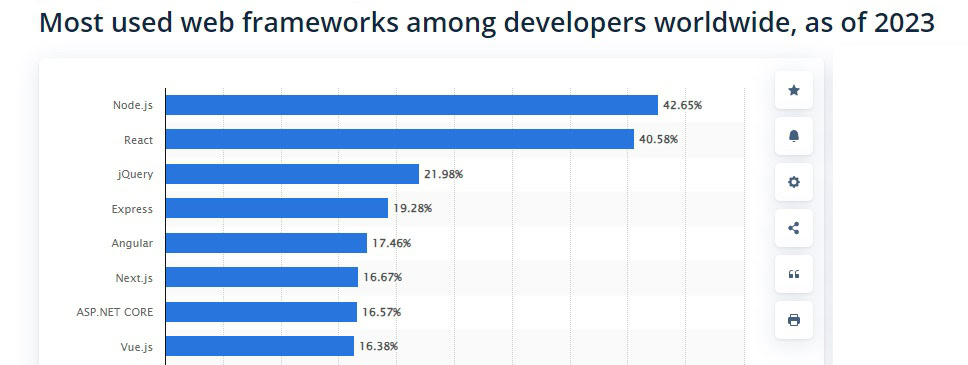
- React became the second most popular framework after Node.js in 2023.
- Nowadays Node.js is one of the most popular JavaScript Framework.
- Vue continues to evolve.
- TypeScript is growing rapidly.
JavaScript Developer Trends and Preferences:
- About 80% of JavaScript developers currently focus on websites as their primary work.
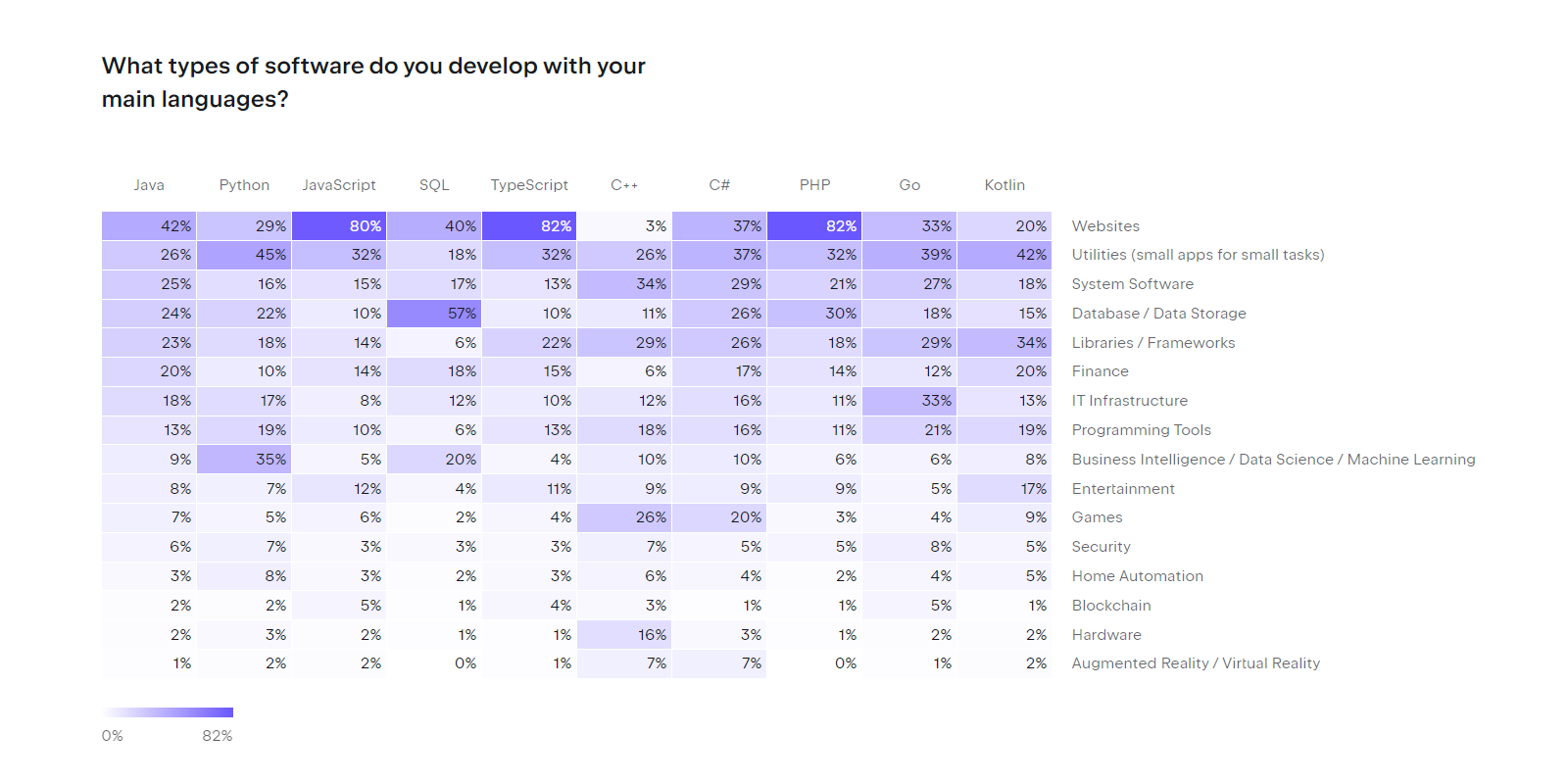
- 86% of JavaScript developers focus on frontend projects and 34% contribute to the backend.
- Salary Insights: For the most part, Javascript developers make between $50,000 and $100,000 per year, and there is a clear inclination towards the United States of America.
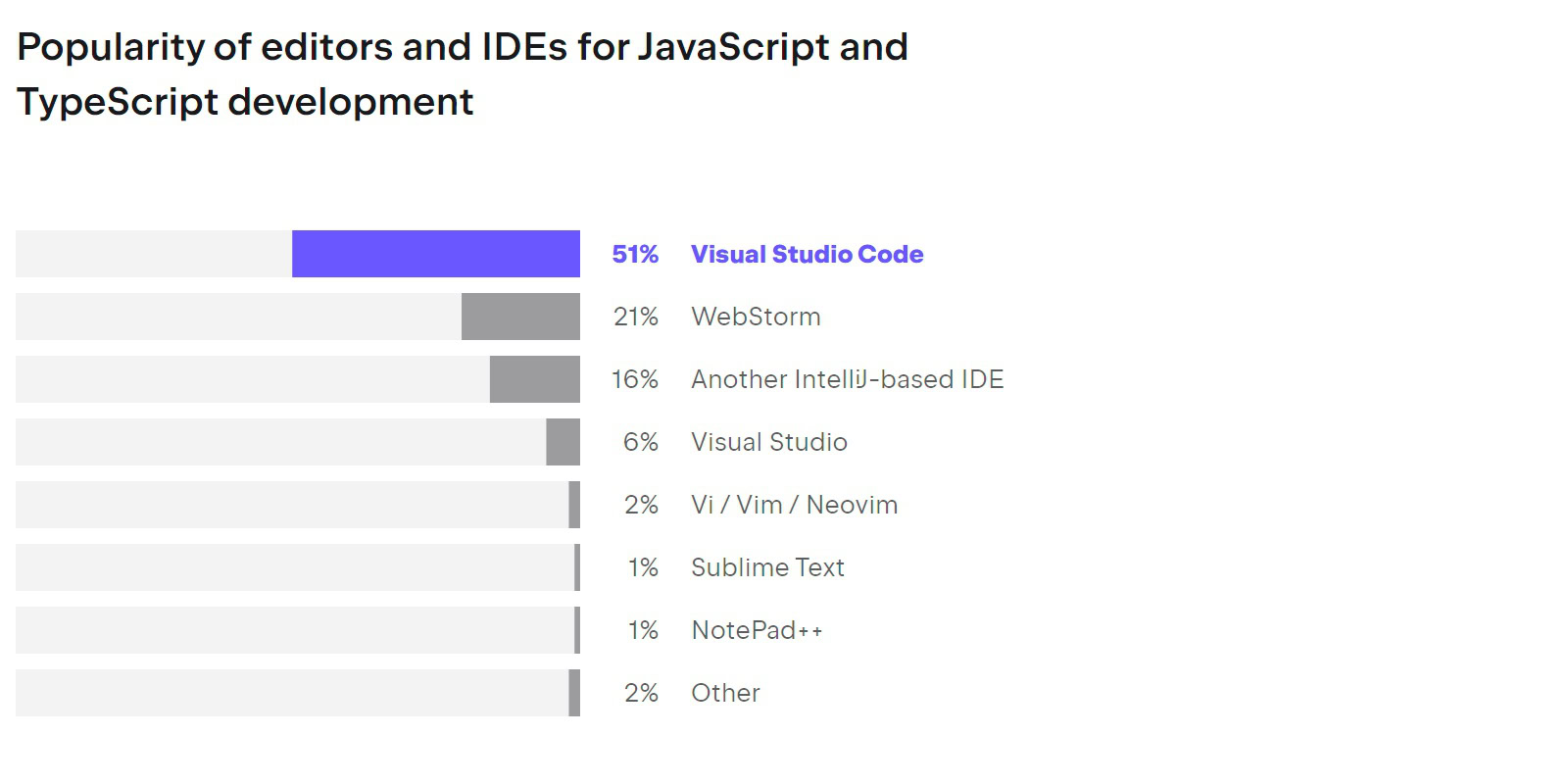
- Almost half of the contributors (51%) use Visual Studio Code for their JavaScript and TypeScript programming.
JavaScript Market Share and Industry Adoption:
- TIOBE Index: Even though JavaScript faces various challenges, it holds a 3.21% rating, with Python beating it in the TIOBE Programming Community Index 2023.

- PYPL Index: With a 3 position on the PYPL Index, JavaScript proves to have the highest demand among global software developers.
- Developer Stacks: JavaScript with 6,471 stacks made by developers implies its mainstream use and importance in the community of developers.
- Global Reach: JavaScript enjoys a monopoly in its presence in different industries with comprehensive global adoption, especially in the US, Germany, France, the UK, and India.
- Industry Preference: The versatility and applicability of JavaScript have enabled its use in industries such as Technology and Programming, E-commerce, and Retail, as well as the Financial sector.
The Future of JavaScript and Its Impact on Business Growth:
- The consistent dominance of JavaScript as well as fresh frameworks and libraries means that we can expect constant expansion and improvements that will lead to business growth and success.
- 2024 will be the year of the popularity of Progressive Web Applications (PWAs).
- AI and ML are having a tremendous effect on web development. We expect that in 2024 we will have more attempts to implement these technologies in JavaScript frameworks.
- The employment of serverless architecture is a rather simple and money-saving option. Hence it is trendy because JavaScript is among the most important technologies for serverless development.
Driving Business Growth with JavaScript
The use of JavaScript can speed up business growth by creating more user-oriented and interactive websites, increasing website performance and SEO ranking. Learning about JavaScript Usage Statistics will allow you to see that these can be used to make correct decisions for your web development strategy.
The importance of JavaScript for business growth is quite evident as it supports dynamic content, user-friendly navigation, and responsive design which in turn result in higher engagement and retention rates. Through the optimized JavaScript on your site, more interactive experiences are provided, resulting in happy and loyal users.
In addition to that, JavaScript significantly influences the speed of webpage loading. Improving your JavaScript code in optimizing it will be the key to reducing page load times, site speed, and overall user experience. This not only enhances the experience for your users but also brings positive changes to your SEO rankings, as search engines give preference to speedy and high-performing websites. Keep an eye on the latest JavaScript statistics to stay on top of industry trends and custom needs.
The Challenges and Opportunities of JavaScript Development
Although JavaScript requires certain development expertise, it offers many chances for creativity and development. Learning JavaScript Usage Statistics and keeping an eye on the latest market trends will allow you to overcome these complications and harness the full potential of JavaScript.
Some common challenges include:
- Staying abreast of the fast-paced nature of the JavaScript ecosystem where new features, libraries, and frameworks are coming out regularly.
- Debugging and error handling of complex JavaScript applications that use higher debugging techniques.
- Tackling security issues, since JavaScript is a widely used tool in web applications and vulnerable to cyberattacks.
Despite these challenges, JavaScript offers compelling opportunities:
- Being cross-browser compatible, JavaScript can run on all major web browsers, and is great for building cross-platform web and mobile applications.
- A feature-rich environment ecosystem of libraries, frameworks, and tools that can be used to supercharge functionality and performance.
- Dynamic and engaging tools that can dramatically enhance user interaction and participation.
- The introduction of backend development using Node.js allows businesses to create fast, scalable, and lightweight web applications.
- New technologies, such as machine learning, artificial intelligence, and data analysis, JavaScript being the main contributor, provide innovative areas for development.
By knowing the latest JavaScript statistics and trends, you can overcome the challenges and harness the massive potential of JavaScript that is sure to propel your business to the next level.
Conclusion
Javascript statistics is a powerful tool for decision-makers like you. Knowing the JavaScript Usage Statistics and staying updated with the latest trends will empower you to take the right actions that boost your business growth and success.
JavaScript statistics give useful information on language adoption, popularity, and web development in general. This knowledge enables you to entwine your website development strategies, recruiting processes, and technology investments with emerging customer desires and market trends. Utilizing these data will help you improve your websites to enhance the user experience contributing to more conversion, retention, and growth in revenue.
As the web development landscape continues to evolve, staying ahead of the curve is crucial. By closely monitoring JavaScript statistics and trends, you can maintain a competitive edge, adapt to emerging technologies, and capitalize on new opportunities for innovation.
The web development terrain is always changing. Thus, it is essential to keep up with the latest trends. By monitoring JavaScript statistics and trends closely you will be in a better position to gain a competitive threshold in the industry; adopt new technology, and take advantage of new opportunities for innovation.












